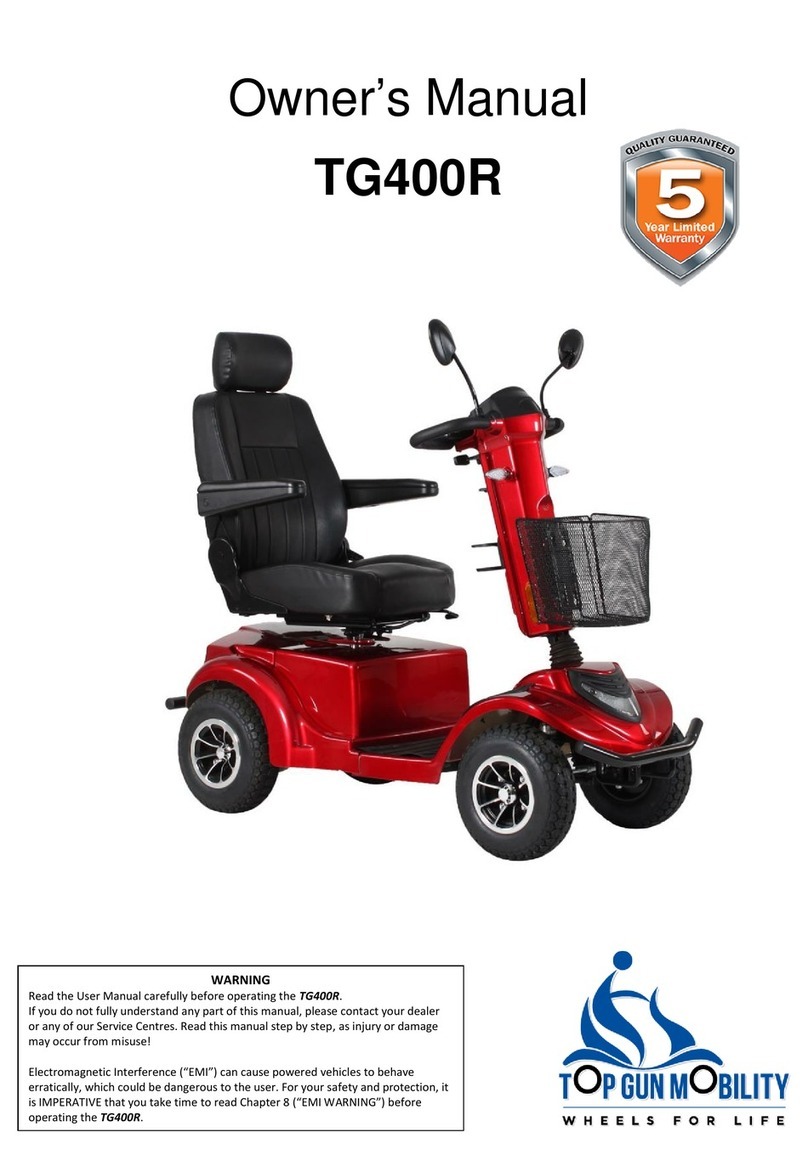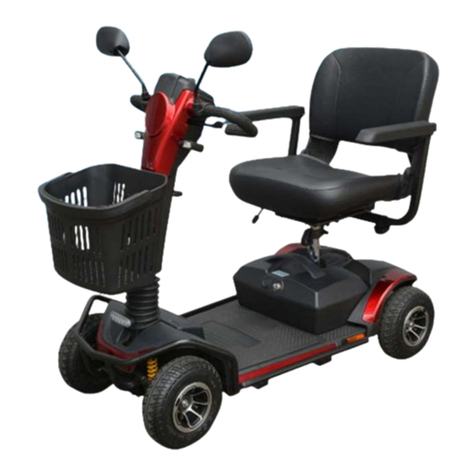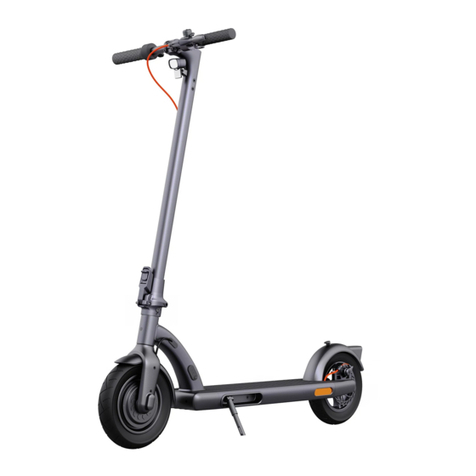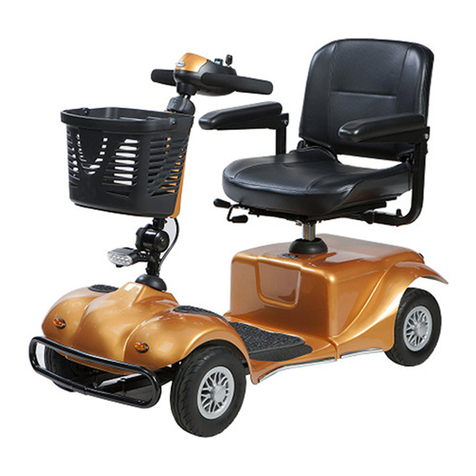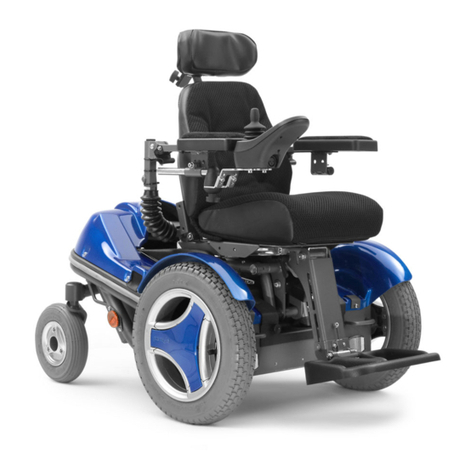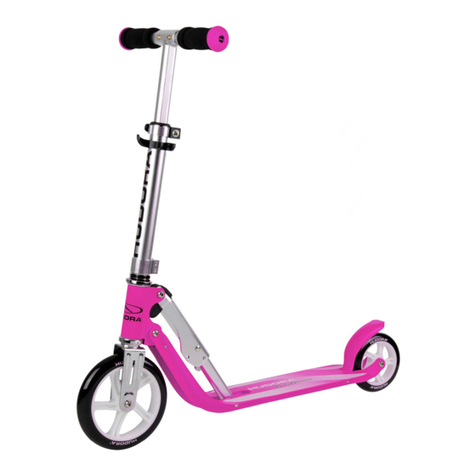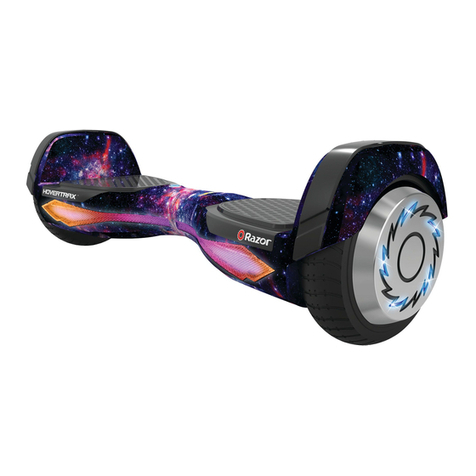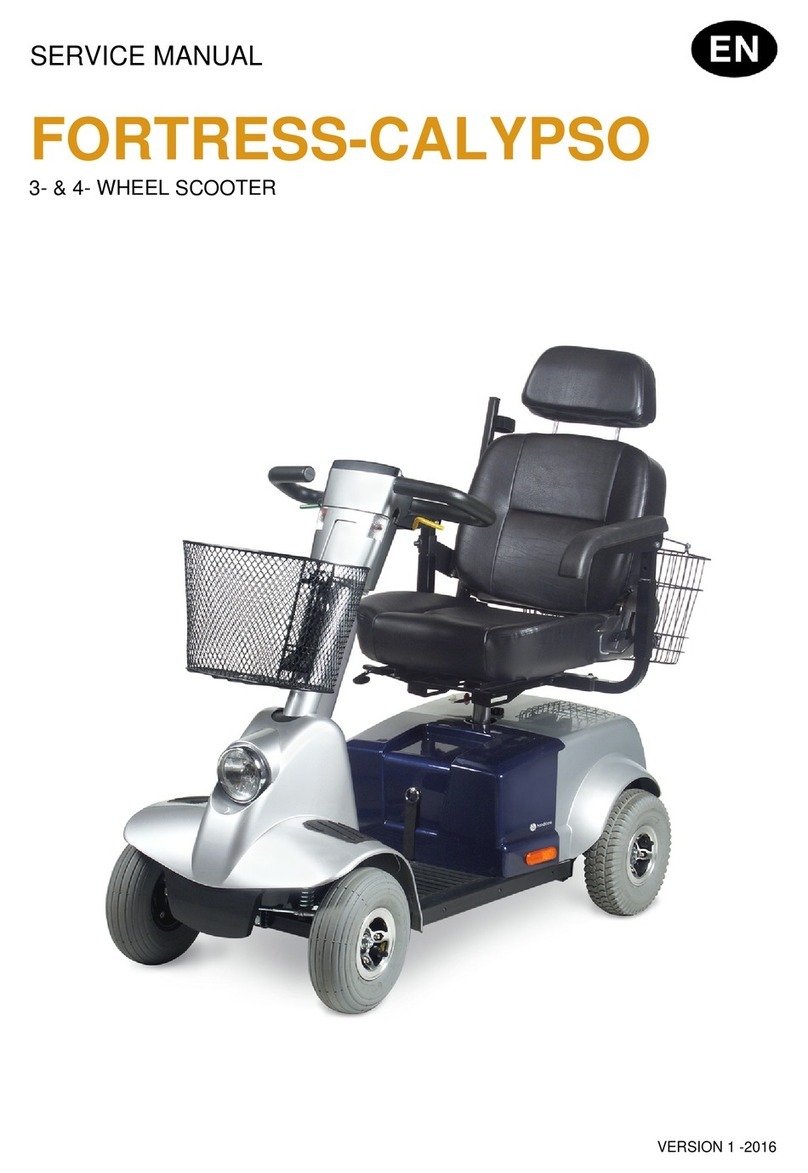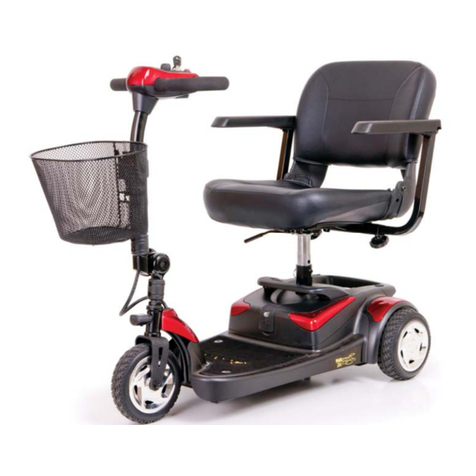Top Gun Mobility TG600RS User manual

Owner’s Manual
TG600RS
WARNING
Read the User Manual carefully before operating the TG600RS.
If you do not fully understand any part of this manual, please contact your dealer
or any of our Service Centres. Read this manual step by step, as injury or damage
may occur from misuse!
Electromagnetic Interference (“EMI”) can cause powered vehicles to behave
erratically, which could be dangerous to the user. For your safety and protection, it
is IMPERATIVE that you take time to read Chapter 8 (“EMI WARNING”) before
operating the TG600RS.

Page | 1
TABLE OF CONTENTS
I. Introduction 2
II. Specifications 3
III. Features 4
IV. Set Up 5
V. Operating your Scooter 6
VI. Safety Instructions 8
VII. Battery Charging 12
VIII. Maintenance Schedule 13
IX. Warranty & Storage Instructions 14
X. Buyers Registration Form 16

Page | 2
I. INTRODUCTION
Top Gun Mobility is happy to provide you our innovative mobility scooter, the
TG600RS scooter. This type of mobility assistive device is designed for anyone
who needs an easy and quiet mode of transportation.
Our scooters are designed to provide personal freedom, as well as
convenience, comfort and the assuredly of a high performance level combine
with a long life cycle.
This manual contains important information concerning the proper maintenance
and safe operation of your scooter.
Please read this manual thoroughly and carefully prior to operating your
TG600RS to familiarise yourself with all operation instructions. If you have any
questions concerning the operation or maintenance, please contact our
dealership.
Your TG600RS has many unique features not found on other scooters. With
proper care and maintenance, you should enjoy many years of dependable
service from your unit.
Your TG600RS should receive regular maintenance according to the schedule
outlined in this manual, and any recommendations from our workshop.
By following the maintenance instructions, you will be able to take care of most
of your unit’s needs. If you are unable to correct a fault in your scooter, please
contact our dealership.
DISCLAIMER
The manufacturer reserves the rights of final interpretation on the manual. For
any printing mistakes or new improvements, the manufacturer will update in the
new editions

Page | 3
II. SPECIFICATIONS
Battery
55AH*2
Motor Power
1400W
Controller
PG 120A
Electric Brake
Warner 24v
Overall Dimensions
1550×680×1280mm
Weight W/O Battery
110 KG
Total Weight W/Battery
145KG
Max. Loading Weight
205KG
Max. Speed (klm/hr)
10KM/H
Turning Radius
1.35m
Max. Climbing Grade
15°
Wheel Size - Front
14'' pneumatic
Wheel Size - Rear
14'' pneumatic
Drive System
24V Sealed Mid Transaxle
Ground Clearance
100MM
Travel Range
up to 45 km
Free Wheeling
Manual Electric
Wheel Hub
Aluminium Alloy
Charger Size
24V 5A

Page | 4
III. FEATURES
•Adjustable seat height
•Swing away armrests
•360 degrees swivel seat, fully reclining
•Adjustable Forward/Reverse Seat
•Adjustable tiller
•Dynamic regenerative braking coupled with fail-safe electro-mechanical
disk brake
•Rear wheel direct drive with differential
•Fully solid state controller
•External Battery Charger
•24-volt permanent magnet heavy duty DC motor
•ON/OFF switch lock
•Horn
•Head light
•Turning lights
•Rear lights
•Battery charge indicator
•Anti-tip-off safety wheels
•Luggage basket
•Front and rear bumpers
•Electronic Brake Release
•Automatic shut off while not in use
•Electronic High/Low speed switch

Page | 5
IV. SET UP
•Remove battery cover.
•Place two batteries onto the battery pan and secure them.
•Join the battery terminals with the receptacle from the controller box.
•Join all cables with the same labelling, except the wire for turning lights.
•Lift up the rear shroud and connect the wire for the turning lights.
•Pull seat swivel lever. Put the seat on the top of the seat post and lock
the seat in position by releasing the lever.
•Adjust the height of the seat with the bolt under the seat.
Battery Pan
DRIVING TEST
•Insert the power key into the key switch and switch on.
•Check the battery charge indicator to make sure the batteries are fully
charged.
•Make sure that clutch lever is at close position.
•Set the speed limit by turning the dial knob on the top of the console. Set
Hi/ Lo switch to Lo position.
•Test the scooter by moving forward, stop, and backward a couple of
times to make sure that your scooter is in proper working condition.

Page | 6
V. OPERATING YOUR TG600RS
•TURN POWER ON
Insert 6 the key into the key switch on the upper tiller and turn on the
power
•FORWARD MOTION
To move forward, pull the right side of the throttle lever under the control
console toward you. The further you pull, the faster the scooter will go.
The maximum speed may be selected by the speed selection switch
located on the top of the control console
•REVERSE MOTION
To reverse, pull the left side of the throttle lever under the control console
toward you. Reverse speed is limited to 4.8 km/h.
Indicator for left turning
Power Indicator
Problem Indicator
Speed Adjustor
Left Turning
Push
Hazard
Indictor for right turning
Indicator for head light
Low gear and high gear indicator
Low gear and high gear indicator
Right turning
Head Light
Horn

Page | 7
•STOP
To stop the scooter, just release the throttle lever. The TG600RS will
quietly come to a smooth stop and electromechanical brake will
automatically engage to hold the scooter in position on horizontal surface
or an incline of up to 15 degrees. Quick smooth stops are made possible
by the dynamic braking built in the controller.
WARNING :
The brake may not be as effective when engaged on inclines greater than 15 degrees
or 21% if the occupant’s weight exceeds 551 pounds.
In case the brake fails to engage, the TG600RSs may roll slowly on a slope. Turn off
the power immediately.
•MOVE MANUALLY
When in operation, the clutch release lever is in its engaged position. To
move the scooter manually, release the clutch lever mounted on the
gearbox under the rear shroud. Should you wish to freewheel
theTG600RS, pull the lever to its release position? Or you can press the
PUSH button to release the brake. Take your finger off the PUSH
button, and the brake will re-engage.
Clutch Release

Page | 8
VI. SAFETY INSTRUCTIONS
The following guidelines are intended to assist you in the safe operation of your
TG600RS scooter. If you have any questions about the correct operation of
your scooter, please contact your authorized dealer. Consult your physician if in
doubt of your ability to operate the scooter.
Your scooter can negotiate grass, gravel, dirt, and sand surfaces, as well as
hard paved or carpeted surfaces. However, extra caution should be taken when
operating your unit on uneven surfaces.
There are some concerns about electromagnetic interference to powered
wheelchairs and scooters. You need to know what EMI (Electromagnetic
Interference) is and how to prevent such incidents. The following paragraphs
suggested by the FDA are intended to provide you some important information
about this.
CAUTION: IT IS VERY IMPORTANT THAT YOU READ THIS
INFORMATION REGARDING THE POSSIBLE EFFECTS OF
ELECTROMAGNETIC INTERFERENCE ON YOUR POWERED SCOOTER.
Electromagnetic Interference (EMI) From Radio Wave Sources
Powered wheelchairs and motorized scooters (in this text, both will be referred
to as powered wheelchairs) may be susceptible to electromagnetic interference
(EMI), which is interfering electromagnetic energy (EM) emitted from sources
such as radio stations, TV stations, amateur radio (HAM) transmitters, two-way
radios, and cellular phones. The interference (from radio wave sources) can
cause the powered wheelchair to release its brakes, move by itself, or move in
unintended directions. It can also permanently damage the powered
wheelchair’s control system.
The intensity of the interfering EM energy can be measured in volts per meter
(v/m). Each powered wheelchair can resist EMI up to certain intensity. This is
called its “immunity level.” The higher the immunity level is, the greater the
protection. At this time, current technology is capable of achieving at least a 20-
v/m immunity level, which would provide useful protection from the more
common sources of radiated EMI. The immunity level of this powered scooter
as shipped, with no further modification, is not known.
There are ample sources of relatively intense electromagnetic fields in the
everyday environment. Some of these sources are obvious and easy to avoid.
Others are not apparent and exposure is unavoidable. However, we believe
that by following the warnings listed below, your risk to EMI will be minimized.

Page | 9
The sources of radiated EMI can be broadly classified into three types:
1) Hand-held portable transceivers (transmitters-receivers) with the antenna
mounted directly on the transmitting unit. Examples include: citizens
band (CB) radios, “walkie talkie,” security, fire, and police transceivers,
cellular telephones, and other personal communication devices. **Note:
Some cellular telephones and similar devices transmit signals while they
are ON, even when not being used.
2) Medium-range mobile transceivers, such as those used in police cars,
fire trucks, ambulances, and taxis. These usually have the antenna
mounted on the outside of the vehicle; and
3) Long-range transmitters and transceivers, such as commercial broadcast
transmitters (radio and TV broadcast antenna towers) and amateur
(HAM) radios.
Note: Other types of hand-held devices, such as cordless phones, laptop
computers, AM/FM radios, TV sets, CD players, and cassette players, and
small appliances, such as electric shavers and hair dryers, so far as we know,
are not likely to cause EMI problems to your powered wheelchair.
Powered Scooter Electromagnetic Interference (EMI)
Because EM energy rapidly becomes more intense as one move closer to the
transmitting antenna (source), the EM fields from Hand-held radio wave sources
(transceivers) are of special concern. It is possible to unintentionally bring high
levels of EM energy very close to the powered scooter’s control system while
using these devices. This can affect powered scooter movement and braking.
Therefore, the warnings listed below are recommended to prevent possible
interference with the control system of the powered scooter.
WARNINGS
Electromagnetic interference (EMI) from sources such as radio and TV stations,
amateur radio (HAM) transmitters, two-way radios, and cellular phones can
affect powered scooter and motorized scooters. Following the warnings listed
below should reduce the chance of unintended brake release or powered
scooter movement, which could result in serious injury.
1) Do not operate hand-held transceivers (transmitters-receivers), such as
citizens band (CB) radios, or turn ON personal communication devices,
such as cellular phones, while the powered scooter is turned ON.

Page | 10
2) Be aware of nearby transmitters, such as radio or TV stations, and try to
avoid coming close to them;
3) If unintended movement or brake release occurs, turn the powered
scooter OFF as soon as it is safe.
4) Be aware that adding accessories or components, or modifying the
powered scooter, may make it more susceptible to EMI (Note: There is
no easy way to evaluate their effect on the overall immunity of the
powered scooter.
5) Report all incidents of unintended movement or brake release to the
powered scooter manufacturer, and note whether there is a source of
EMI nearby.
If unintended motion or brake release occurs, turn the power OFF as soon as it
is safe. The following warning label is attached to your scooter in order to
make users always aware that a possibility of electromagnetic interference
exists.
WARNING: Radio wave sources may affect scooter control
Radio wave sources, such as radio stations, TV stations, amateur radio (HAM)
transmitters, cellular phones, and two-way radios, can affect motorized
scooters. Following the warnings listed below should reduce the chance of
unintended brake release or scooter movement, which could result in serious
injury.
•Do not turn ON or use hand-held personal communication devices, such
as citizens band (CB) radios and cellular phones, while your scooter is
turned ON;
•Be aware of nearby transmitters, such as radio or TV stations and hand-
held or mobile two-way radios, and try to avoid coming close to them.
•If unintended movement or brake release occurs, turn the power OFF as
soon as it is safe.
•Be aware that adding accessories or components, or modifying your
scooter, may make it more susceptible to interference from radio wave
sources. (Note: There is no easy way to evaluate their effect on the
overall immunity of the scooter). Report all incidents of unintended
movement or brake release to the scooter manufacturer, and note
whether there is a radio wave source nearby.

Page | 11
Important Information:
•20 volts per meter (v/m) is a generally achievable and useful immunity
lever, against interference from radio wave sources (as of May 1994)
(the higher the lever, the greater the protection);
•The immunity level of this product is not known.
IN SUMMARY
DO NOT try to climb sharp curbs
DO NOT drive off or over obstacles exceeding 5 cm in height
DO NOT make abrupt changes in direction at high speed or while traveling on
an incline
DO NOT attempt to make fast turn on flat surfaces
DO NOT climb inclines greater than 15 degrees
DO NOT back your scooter on uneven surfaces or inclines
DO NOT attempt to operate your unit in a stalled condition, such as traveling up
very steep incline. This may cause the circuit break or thermal cut out,
rendering your unit temporarily immobile
DO NOT travel on highways and freeways; ALWAYS stay in the bike lanes and
sidewalks
DO NOT carry passengers in any manner
DO NOT operate your unit when the red battery indicator light is flashing
DO NOT operate your unit with the clutch lever in the disengaging position
DO NOT mount or dismount your unit with power switch in the “ON” position
ALWAYS make sure that the steering tiller adjustment lever is locked
ALWAYS make sure that the seat is locked so that it will not swing during
operation
DO NOT turn ON or use hand-held personal communication devices, such as
citizens band (CB) radios and cellular phones, while your scooter is turned ON
BE AWARE of nearby transmitters, such as radio or TV stations and hand-held
or mobile two-way radios, and try to avoid coming close to them
BE AWARE that adding accessories or components, or modifying your scooter
may make it more susceptible to interference from radio wave sources.

Page | 12
VII. BATTERY CHARGING
To ensure the best performance and maximum battery life, we recommend
frequent battery charging. Your TG600RS comes with an external battery
charger for your ease and convenience. The console battery display makes
charging simple and easy. It is recommended that you charge your scooter
every night. Follow these steps for battery charging.
1) The console battery level display has red lights; each indicates 10% of
battery charge. This acts like an automobile fuel gauge.
2) On a level, dry surface, turn off the power key and plug the extension
cord into the charger socket located on the steering console. Then plug
the other end of the charger cord into a wall outlet.
3) Charge the battery for 6-8 hours depending on the usage before
charging. Disconnect the charger from the wall outlet, disconnect the
extension cord from the scooter, insert key into tiller and check if all
gauge lights are on.
There is no possible way to overcharge the battery as the charging voltage is
set constant. In general, you may start charging before you go to bed at night
and disconnect it in the next morning.
Battery Charger Hook Up

Page | 13
VIII. MAINTENANCE SCHEDULE
In order to obtain the best performance and lasting service life, please maintain
your unit according to the following schedule and instructions:
DAILY
•Check brake effectiveness before you drive.
•Recharge batteries fully every night.
WEEKLY
•Check tyre pressure. The pressure should be 21 psi.
•Clean seat upholstery, plastic body and covers. To avoid the electrical
failure, do not spray water directly to your unit. Use a damp clean rag to
clean all parts.
•Check and tighten the throttle lever attachment screws.
MONTHLY
•Check battery condition. Clean terminals if necessary.
•Check all electrical wire connectors to eliminate loose connection.
•Tighten all exposed bolts and nuts.
•Check wheel bearings by spinning tyres and checking for free rotation.
YEARLY
•Visit your dealer and let technician check your scooter completely.

Page | 14
WARRANTY
This is to certify that your TOP GUN MOBILITY product offers a limited 5 Year
Warranty from the date of original purchase. This warranty is not transferable.
Should a defect or operating fault arise within this period the Dealer, from where
the product was originally purchased, should be notified immediately. Failure to
register the fault may invalidate the warranty.
The Dealer from where the product was purchased is responsible for any
warranty repairs.
Top Gun Mobility warrants that if a fault occurs within this period due to faulty
workmanship or materials that the product will be repaired (or replaced at the
Company’s discretion) free of charge.
Any unauthorised modifications will invalidate the warranty.
Component parts replaced outside this period carry a six-month warranty.
(Standard terms and conditions apply for this period).
FIVE-YEAR LIMITED WARRANTY
•Structural frame components, including: platform, fork, seat post, and
frame welds.
•Drivetrain, including: differential, motor, and brake.
THREE-YEAR LIMITED WARRANTY
Your Top Gun Mobility Scooter is fully guaranteed for three (3) years from the
date of purchase against faults arising due to defects in manufacture or
materials. This warranty does not detract from, but is in addition to your legal
rights.
All electronic parts, including controllers and battery chargers, have a one (1)
year warranty. Servicing to the controller or battery charger must be carried out
by your authorised Top Gun Mobility Provider. Any attempt to open or dismantle
these items renders the guarantee void on that item.
NOT COVERED UNDER WARRANTY
The guarantee goes not extend to those items which may need replacement
due to normal wear and tear (tyres, belts, bulbs, upholstery, plastic shrouds,
motor brushes, fuses, and batteries), or damage to the product caused by
misuse or accident for which Top Gun Mobility or its agent cannot be held
responsible. This warranty does not include labour or service calls.
WARRANTY SERVICE PERIOD
Every twelve (12) months from date of purchase. We recommend using a Top
Gun Mobility Service Provider.

Page | 15
SERVICE CHECKS AND WARRANTY SERVICE
Warranty service can be performed by an authorised Top Gun Mobility Provider.
Please contact your authorised Top Gun Mobility Provider for advice on the
current cost affecting the service visit.
YOUR OBLIGATIONS UNDER THIS WARRANTY
It is a condition of this warranty that your Mobility Scooter must be maintained in
accordance with the manufacturer’s servicing intervals (every 12 months) and
requirements.
STORAGE INSTRUCTIONS
Always store in a dry area protected from freezing to avoid damage to the
scooter and premature wear of the batteries.
Avoid exposure to rain, snow, ice, salt or stagnant water. Keep your scooter
clean and dry.
Never expose the electronic components of the scooter to humidity (rain, snow,
mist, or water from washing), as it may damage electronic circuits.
Always store your scooter with batteries fully charged. When storing the scooter
for more than two weeks, charge the batteries and disconnect them.
During the storage, check the charge once a month and recharge the batteries
as needed. You must complete a full charge cycle every month or damage to
batteries can occur.
Avoid extreme temperature of hot and cold during storage. Freezing can
damage low charged batteries and they may become unusable.
Model: _________________________________________________________
Serial No: _______________________________________________________
Purchase Date: __________________________________________________
D
ea
ler
S
t
a
mp

Page | 16
Buyers Registration Form
Top Gun Mobility Scooter
NOTICE: SELLING DEALER SHOULD COMPLETE THIS FORM AT TIME OF
SALE TO REGISTER WARRANTY.
Customer Name:_ _______________________________________________
Address:________________________________________________________
City:_____________________________ State: _______Postcode:__________
Telephone:__________________________Date of Purchase:______________
Email Address: ___________________________________________________
Selling Dealer: Top Gun Mobility
21 Brisbane Street, Ipswich QLD 4305
Phone : 07 3282 7788
Email : info@topgunmobility.com.au
Model: _________ TG600RS ______________
Serial Number: _______________________________________________
Colour: _______________________________________________
Type of Purchase: Consumer Rental Other
Customer Signature
Dealership Representative Signature
Table of contents
Other Top Gun Mobility Scooter manuals


